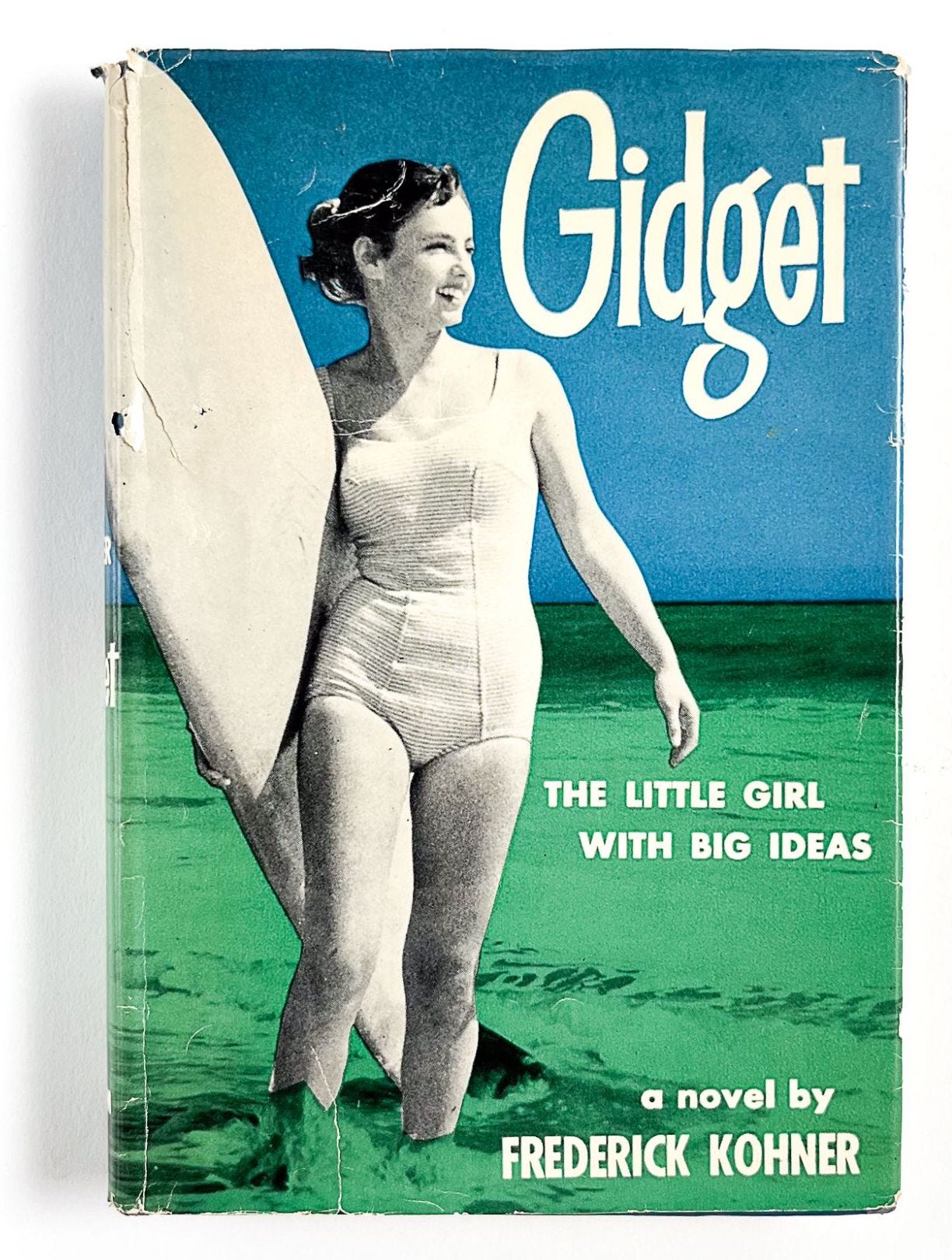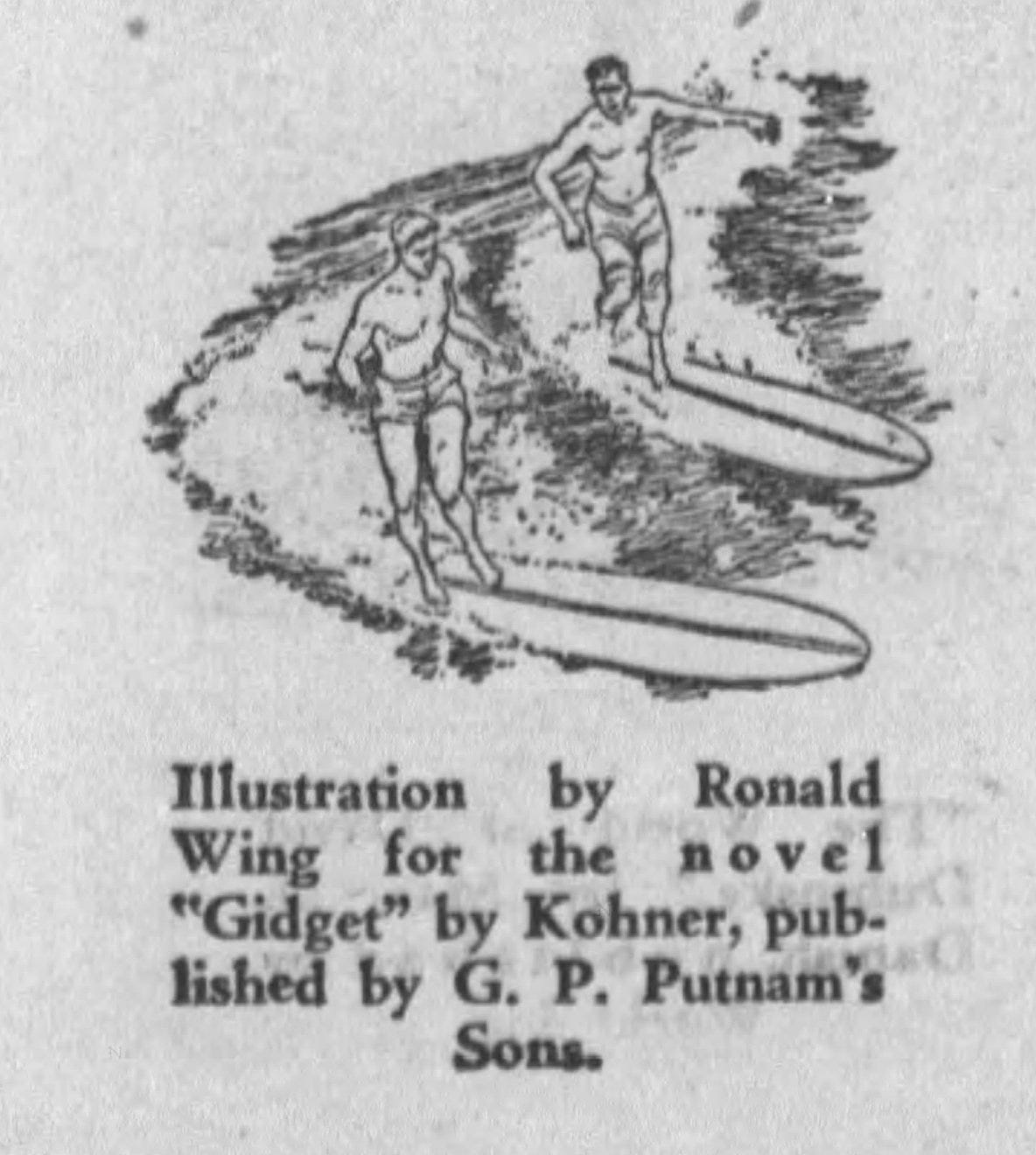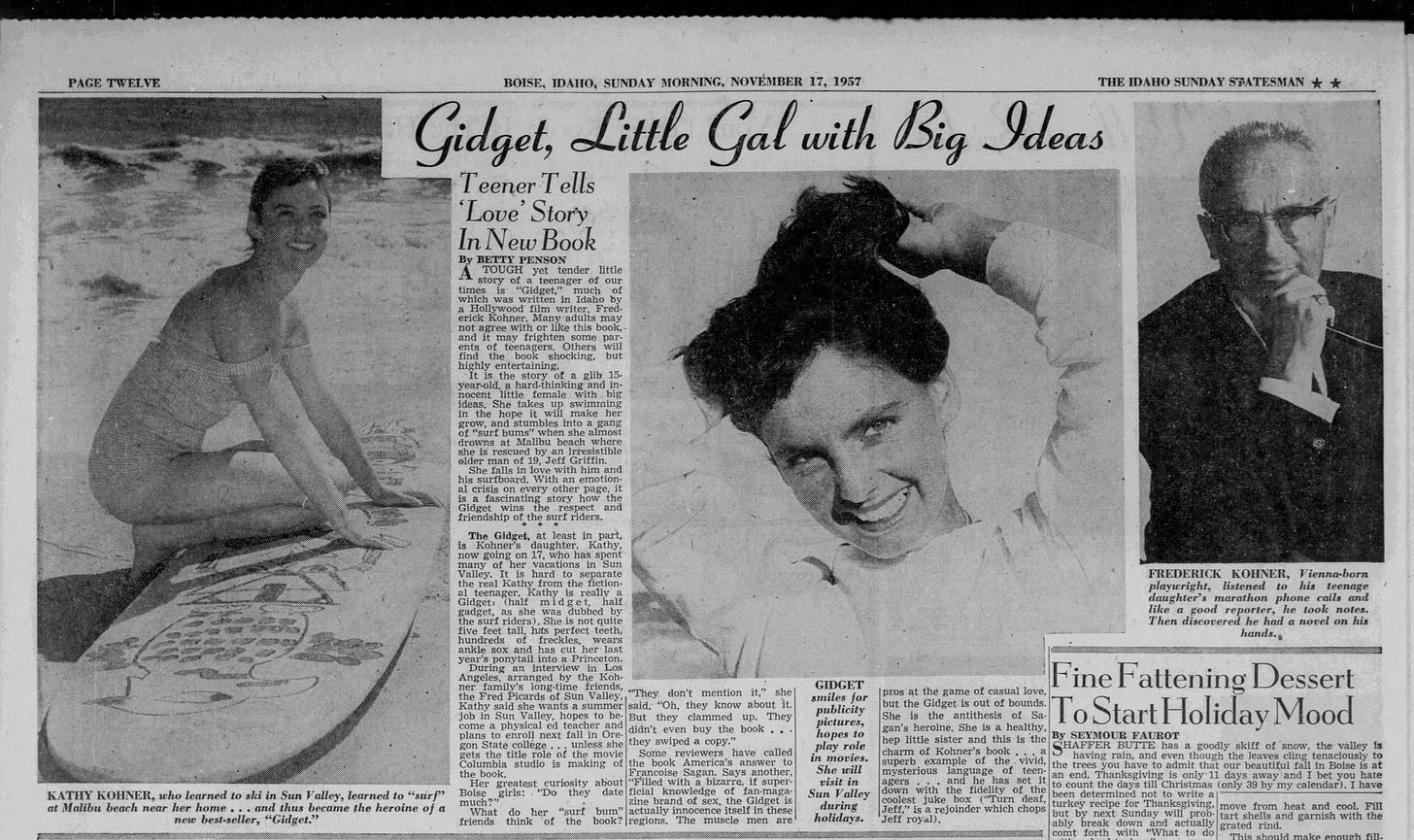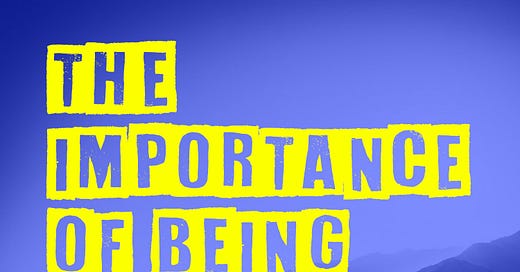The Importance of Being Gidget (Part 1): The Father, the Daughter, and the Novel
How a novel written by a Jewish exile from Nazi Germany helped launch the modern Southern California surf craze and Beach Party movies of the 1960s
PLEASE NOTE: This article also includes an audio version of the author reading the article (above).
Sometime in the mid-1950s, Frederick Kohner sat down to write a novel about a teenage girl named Franzie, who was based not too loosely on his own teenage daughter, Kathy.
Kathy was routinely participating in a newly emerging sport that was flourishing on the coast of Southern California by this time: Surfing. She had bought a surf board for $35, and she headed out to the beach to use it every chance she got.
Kathy’s father, Frederick, recognized the exciting potential of turning her unique story into a novel.

Frederick Kohner was born in 1905 in a part of the Austro-Hungarian Empire that’s now in the Czech Republic. He studied at the University of Vienna and obtained a PhD from the Sorbonne in Paris, and he worked in a number of professions – including newspaper correspondent and actor – before going to work for German film studios as a writer.[1] In 1936, Kohner relocated to the United States and became a modestly successful screenwriter, story developer, and script doctor in Hollywood. His brother, Paul, was an influential producer and talent agent in Los Angeles.

The Kohner brothers, being Jewish exiles from Nazi Germany, transferred their talents from the German film industry to its larger American behemoth counterpart: Hollywood. On several occasions, Paul hired Frederick to write screenplays and work on stories for films he was producing. Frederick banged out scripts for such unexceptional films as Lake Placid Serenade (1944) and Three Darling Daughters (1948).
It's safe to say that if Frederick Kohner hadn’t written Gidget, he would be forgotten today. His main motive for writing the book, Kohner would tell interviewers, was to get to know the world that his daughter Kathy inhabited. At the time, the Kohner family lived in an affluent Brentwood neighbourhood in Los Angeles, and Kathy – age 15 when the book was being written – surfed at Malibu Beach as often as possible.
To prepare for writing the book, Kohner studied the lingo of adolescents. He wanted to get that teenage vernacular just right.[2] Even though Kohner named the main character in his book “Franzie,” he eventually called the novel Gidget: The Little Girl with Big Ideas, a titled derived from a portmanteau of the words “girl” and “midget.”
Gidget!
Kohner wrote Gidget as a first-person narrated coming-of-age story, aimed squarely at young readers. The novel is narrated by a teenage girl named Franzie, who is navigating the challenges of adolescence and discovering her identity along the way. She is depicted as an enthusiastic and adventurous teenager who learns to surf and meets a lot of colourful individuals on the beach along the way.
Reading Gidget decades after it was written, it is impossible to escape the comparisons to J.D. Salinger’s enormously influential coming-of-age novel Catcher in the Rye, published in 1951, six years before Gidget. In fact, when Gidget’s publisher, G.P. Putnam's Sons, sent copies of the newly published book to newspaper reviewers, they included a press release comparing it to Salinger’s famous novel.[3]

Franzie often sounds a great deal like a female Holden Caulfield in Gidget. She speaks in a style similar to Holden, right down to her cadence and use of hyperbolic slang. Early in the novel, when Franzie contemplates writing about her experiences surfing while sitting near the ocean with a pencil and a notebook, she offers the following observations about herself:
“So the longer I sat there and thought about this writing business, the more I realized it wasn’t for me. First of all, my vocabulary is really terrible and if I tried to use all those expensive words, they wouldn’t be mine and besides, as I’ve pointed out, all I want to do is not to forget when I’m an old hag like Mrs. Hotchkiss down the street, with nothing to show for a long life but forty-five bucks of Social Security a month and crippling arthritis.”[4]
Despite the similarities between the narrative styles of Franzie and Holden, their personalities are strikingly different. Franzie is not the tortured soul that Holden was. She possesses much stronger self-confidence than Holden.
At one point in Gidget, again quite early in the book, Franzie describes herself for the mind’s eye of the reader:
“I guess the whole thing started because I’m so short. I’m not quite five feet but if it hadn’t been for that year-round swimming, I’d probably stayed a dwarf…. I was sixteen last month. I’m really quite cute. I’ve real blond hair and wear it in a horsetail. My two big canines protrude a little, which worries my parents a great deal. They urge me to have my teeth pushed back with the help of some crummy piece of hardware, but I’ve been resisting any attempt to tamper with my personality.”[5]
Franzie befriends the regular suffers of Malibu, all of them young men. They have colourful nicknames like Lord Gallo (so named due to his love of Gallo brand wine), Stinky, Malibu Mac, Golden Boy Charlie, Hot Shot Harrison, Schweppes, Scooterboy Miller, Don Pepe, and Moondoggie.
But the head honcho of these “Go-Heads” (Franzie’s nickname for the surfers) is an older, tanned virile pro – standing above everybody else at 6 feet 4 inches – named Cass (short for Cassius), but who goes by the nickname Kahoona, a variation of the Hawaiian word “kahuna,” which was often used in its modern parlance to describe a wise man, priest, shaman, or leader, or a big wave. But in this case, the misspelled “Kahoona” refers to the quintessential itinerant beach bum, an older wanderer in search of killer waves. Kahoona has journeyed to faraway beaches in Peru, and Hawaii where the surfing is “bitchen” (to borrow a word used countless times by Franzie in the novel).
Kahoona – who is revered as a living legend by the younger surfers – resides in a makeshift “Quonset hut” on the beach. Franzie describes it as “made from bamboo sticks and palmettos and odd pieces of driftwood. There was a crude fence built around it, and in the enclosure some of the surfers were squatting in the sand, their knees drawn under their bodies.”[6]

Perhaps the most compelling element of the novel comes when Franzie defies the gender stereotypes of the period by pursuing surfing, a decidedly male-dominated activity in 1957. At one point in Gidget, Kahoona warns Franzie that surfing is not a sport for females. The following exchange occurs:
The great Kahoona did some more beard scratching. Then he said, “Tell you something, kid. We don’t like dames around here. Not while the sun’s out. They’re always stirring up trouble. Surfing is serious business. Not for dames.”
“I’m not dames,” I said, trying to keep my voice steady.
“You’ve got the potentialities,” said the great Kahoona, and I leaned over. He came very close.
“How old are you, really, kid?”
“I told you — ”
“About fifteen?”
The cannonball was back in my tummy only now it felt like a sack of cement.
“I’ll be sixteen in a few weeks,” I said weakly.
“Don’t let it worry you,” said the great Kahoona. “You’ll get there soon enough.”
“Please don’t tell the others,” I said. “I’ll die.”
The bongo drums were going now like crazy.
Cass reached out and put his big hand over mine. Then he said, “Relax, Gidget. I never told on a pal!”[7]
The male surfers in Gidget accept Franzie into their subculture. They even teach Franzie techniques that help her improve her surfing skills. Franzie falls for one of them, handsome young Moondoggie, whose real name is Jeff. She is drawn to him after he rescues her from violent waves early in the book. Despite Franzie’s efforts to get closer to Moondoggie, he remains cool and indifferent toward her throughout much of the novel.
At a big seaside “luau” later in the novel, Franzie makes overtures toward Kahoona, hoping Moondoggie will notice and get jealous. But she is also attracted to the mysterious older Kahoona, and she gets alone with him and tries to tempt him. The wise older surfer gently rebuffs Franzie, telling her that she should wait to have sex with a special man she loves.
The plot thickens when Moondoggie finds them at Kahoona’s hut and falsely assumes Kahoona has taken advantage of Franzie. A jealous Moondoggie reveals his feelings for Franzie by picking a fight with the legendary surfer. A brawl ensues, and Franzie breaks free from the two men to catch a wave, drawing attention to her newfound abilities as a surfer.
Upon publication in October 1957, Frederick Kohner’s Gidget: The Little Girl with Big Ideas turned into a runaway hit. It climbed to the top of bestseller lists. It flew off the shelves of bookstores across North America. A few literary luminaries even sang its praises. Prolific screenwriter and playwright Ben Hecht gushed: “Gidget is a lively chronicle of modern adolescents. It is a bright sister to Catcher in the Rye, and it makes the happy point that it is possible to be a juvenile without being a delinquent or at war with the world.”[8]

Reviews turned out to be generally favourable, often emphasizing the book’s light-hearted aspects. “The novel is recommended chiefly because it is about a nice set of teen-agers, a welcome relief from the usual fare. These youngsters ride surfboards on the Pacific Coast and they have fun, and the chances are you will, too,” noted a review in the Omaha World Herald.[9] “Easy reading, occasionally exciting, but not much depth,” opined Vera Napier in the Albuquerque Tribune.[10] William Hogan of the San Francisco Chronicle called Gidget “an authentic documentary on the teen-age breed.”[11]
The book also generated a great deal of media coverage outside of the reviews, with Kohner appearing on television and radio shows to discuss Gidget. Many observers at the time were astonished that Kohner could so easily slip into the mind and body of a teenage female. The author stressed in interviews that all he did was listen carefully to his daughter’s stories and her manner of speaking. Reading Gidget, it is remarkable how Kohner managed to capture the voice of a teenage girl so authentically, given his background and age. It speaks to his skill as a writer and his ability to empathize with a completely different perspective.

It helped that Frederick and Kathy Kohner were extremely close. Certain editions of Gidget published photographs of the father and daughter together – in his study in Brentwood, or on the beach at Malibu. In the photos, they look at each other with smiles and adoring eyes.
Years later, Kathy Kohner told an interviewer:
“The novel Gidget is a work of fiction. That definitely has to be established. One could say that it was loosely based on what I told my dad about myself and a guy who lived in a shack who perhaps had the nickname Kahoona. There was somebody in Malibu called Moondoggie, but he was not my love interest. Fictionalized, my love interest became Moondoggie.”[12]
Upon publication, Gidget’s impact proved to be instantaneous. And seismic. Thanks to the novel, the American public enjoyed its first glimpse at California’s newly emerging surfing subculture and its thriving beach scene. “By 1958, all things Malibu had changed — the secret was out. The waves once surfed by a few locals were now the destination for all who would be tan and cool,” observed author Deanne Stillman.[13] Kathy Kohner later recalled: “When the book came out, the guys thought I was spying. Then the movie came out and Malibu got extremely crowded.”[14]
More than any other cultural contribution of the day, Gidget helped to move surfing from the periphery of American life to center stage. The publisher begged for sequels. Columbia Pictures bought the rights to the novel to turn it into a movie. Frederick Kohner claimed to be writing a screenplay for the film, and he insisted that his daughter Kathy – who had never acted in anything before – would play the title role.
Sure enough, Gidget would be made into a film by Columbia, released in March 1959, although Kohner did not write the screenplay for it, and it did not star his daughter Kathy. Yet the film would be a phenomenal success, generating two sequels (Gidget Goes Hawaiian in 1961 and Gidget Goes to Rome in 1963) and a bubbly mid-sixties television series starring newcomer and later Oscar-winner Sally Field in the title role.
Gidget also inspired a series of “Beach Party” musicals made by American International Pictures, including Beach Party (1963), Muscle Beach Party and Bikini Beach (1964), and Beach Blanket Bingo and How to Stuff a Wild Bikini (1965), as well as other imitators, among them Surf Party (1963), Beach Ball (1965), and The Beach Girls and the Monster (1965).
A new “surf sound” also thrived on the radio, energized by the success of Gidget, which included the likes of Dick Dale & His Del-Tones, Jan and Dean, and of course, the Beach Boys. As historian Douglas Booth writes:
“Hollywood beach stories were characteristically musical adventures that boosted the emergent popular surf music. Surfing writer Lee Wardlaw calculates that more than 800 surf bands recorded one song or more in the early 1960s. A simple beat, uncomplicated lyrics, and easy harmonies characterized surf music and complemented the simple plots of the surf films.”[15]
Gidget remains in print today. Frederick Kohner continued to write books, including several sequels to Gidget, none of which enjoyed the commercial success or acclaim of the original. He died in Los Angeles on July 7, 1986, at age 80. Obituaries and tributes to him after his death all referred to him as the author of Gidget.
Here is a wonderful interview with Kathy Kohner-Zuckerman, conducted by writer and sufer Jamie Brisick in 2023 for his podcast for The Sufer’s Journal. She is such an engaging storyteller and this delightful Q&A between two friends is endlessly fascinating. And she reads excerpts from her diary! I promise that once you start listening to this interview, you won’t be able to stop. Please give it a listen if time permits!
Kathy stopped surfing for years and became a travel agent. She married Marvin Zuckerman, a professor of Yiddish and English in Southern California, and she changed her name to Kathy Kohner-Zuckerman. The couple had two sons and, ultimately, multiple grandchildren. Kathy would return to surfing from time to time, and she crisscrossed the country over the decades, appearing at speaking engagements and fan conferences and autographing copies of her father’s book. She was inducted into the Surfing Walk of Fame in Huntington Beach, California, and the Southern California Jewish Sports Hall of Fame.
As Kathy Kohner-Zuckerman reflected in a 2005 interview:
“The book changed my life. I think it changed a lot of people’s lives. People hug me and I have to hug them back. I meet people from all over the world. It’s wonderful. I’m very much at peace, very much at home…. I’m happy I can go back to a place I left behind.”[16]
NOTES
[1] For an excellent biographical article, see Charles Champlin, “The Novel Origins of ‘Gidget,’” Los Angeles Times, September 13, 1986, Part V, 1. See also: Pamela Robertson Wojcik, Gidget: Origins of a Teen Girl Transmedia Franchise (New York: Routledge, 2021).
[2] Steven V. Cronin, “Original ‘Gidget’ Will Land in Ocean City While Promoting Issue of Classic Book,” Press of Atlantic City, August 18, 2005, B6.
[3] E.L. Holland Jr., “Pleasant Summer Interlude: Review of Gidget by Frederick Kohner,” Birmingham News, September 29, 1957, 75. Deanne Stillman, “Introduction,” in Frederick Kohner, Gidget: The Little Girl With Big Ideas (New York: Berkley Books, 2001), xiv-xv.
[4] Frederick Kohner, Gidget: The Little Girl With Big Ideas (New York: Berkley Books, 2001), 6.
[5] Kohner, Gidget, 9-10.
[6] Kohner, Gidget, 17.
[7] Kohner, Gidget, 33.
[8] Bob Campbell, “New Teen-Age Novel Creating Controversy,” Los Angeles Mirror, October 28, 1957, 17.
[9] “Review of Gidget,” Omaha World Herald, January 19, 1958, 107.
[10] Vera Napier, “Review of Gidget,” Albuquerque Tribune, November 23, 1957, 4.
[11] William Hogan, “Gidget, a Little Girl with Great Big Ideas,” San Francisco Chronicle, October 7, 1957, 19.
[12] Susan Dunne, “An Accidental Icon: Kathy Kohner-Zuckerman was the Real Gidget, Inspiration for Her Dad’s Novel,” Hartford Courant, August 14, 2011, G3.
[13] Deanne Stillman, “Introduction,” in Kohner, Gidget, xvi.
[14] Steven V. Cronin, “Original ‘Gidget’ Will Land in Ocean City While Promoting Issue of Classic Book,” Press of Atlantic City, August 18, 2005, B6
[15] Douglas Booth, “Surfing Films and Videos: Adolescent Fun, Alternative Lifestyle, Adventure Industry,” Journal of Sport History, Fall 1996, Vol. 23, No. 3, 315.
[16] Steven V. Cronin, “Original ‘Gidget’ Will Land in Ocean City While Promoting Issue of Classic Book,” Press of Atlantic City, August 18, 2005, B6






Andrew Hunt, is this you? You’re so good!
Hi Andrew - Nice piece and thx for quoting me. I should also add that I'm the person who helped Gidget get the long out-of-print novella reissued, and wrote the full story of how it happened here. Https://www.truthdig.com/articles/americas-mermaid/ After the reissue, Malibu selected it for its One City One Read program and Gidget was resurrected. Https://latimes.com/archives/la-xpm-2005-may-02-oe-stillman2-story.html.